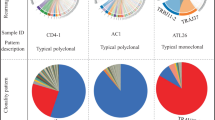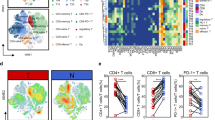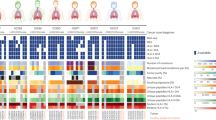Abstract
γδ T cells function as sentinels in early host responses to infections and malignancies. Specifically, γδ T cells recognize tumor-associated stress antigens via T-cell receptor (TCR) γδ and play important roles in the antitumor immune response. In this study, we characterized the pattern of the human TCR γδ complementary determinant region 3 (CDR3) repertoire in patients with lung carcinoma (LC) via high-throughput sequencing. The results showed that the diversity of CDR3δ was significantly reduced, and that of CDR3γ was unchanged in LC patients compared with healthy individuals; in addition, LC patients shared significantly more CDR3δ sequences with each other than healthy individuals. The CDR3 length distribution and N-addition length distribution did not significantly differ between LC patients and healthy individuals. In addition, the CDR3 repertoire tended to use more Vδ2 and fewer Vδ1 germline gene fragments among LC patients. Moreover, we found a combination of four TCR γδ repertoire features that focus on CDR3δ and can be used as a biomarker for LC diagnosis. Our research suggests that the TCR γδ CDR3 repertoire changed in LC patients due to the antitumor immune response by γδ T cells in vivo, and these changes primarily focus on the amplification of certain tumor-specific CDR3δ clones among patients. This study demonstrates the role of γδ T cells from the TCR γδ CDR3 repertoire in tumor immunity and lays the foundation for elucidating the mechanism underlying the function of γδT cells in antitumor immunity.
This is a preview of subscription content, access via your institution
Access options
Subscribe to this journal
Receive 12 digital issues and online access to articles
$119.00 per year
only $9.92 per issue
Buy this article
- Purchase on Springer Link
- Instant access to full article PDF
Prices may be subject to local taxes which are calculated during checkout






Similar content being viewed by others
References
Fisher JP, Heuijerjans J, Yan M, Gustafsson K, Anderson J. gammadelta T cells for cancer immunotherapy: a systematic review of clinical trials. Oncoimmunology 2014; 3: e27572.
Zou C, Zhao P, Xiao Z, Han X, Fu F, Fu L. gammadelta T cells in cancer immunotherapy. Oncotarget 2017; 8: 8900–8909.
Legut M, Cole DK, Sewell AK. The promise of gammadelta T cells and the gammadelta T cell receptor for cancer immunotherapy. Cell Mol Immunol 2015; 12: 656–668.
Chen H, He W. Human regulatory γδT cells and their functional plasticity in the tumor microenvironment. Cell Mol Immunol 2017; 14: 1–3.
Chien YH, Bonneville M. Gamma delta T cell receptors. Cell Mol Life Sci 2006; 63: 2089–2094.
Vantourout P, Hayday A. Six-of-the-best: unique contributions of gammadelta T cells to immunology. Nat Rev Immunol 2013; 13: 88–100.
Xi X, Han X, Li L, Zhao Z. Gammadelta T cells response to Mycobacterium tuberculosis in pulmonary tuberculosis patients using preponderant complementary determinant region 3 sequence. Indian J Med Res 2011; 134: 356–361.
Spencer CT, Abate G, Blazevic A, Hoft DF. Only a subset of phosphoantigen-responsive gamma9delta2 T cells mediate protective tuberculosis immunity. J Immunol 2008; 181: 4471–4484.
Chen H, Ji X, Cui L, Zhang J, He W. Characterization of complementary determinant region 3delta in human MutS homologue 2-specific gammadelta T cells. Scand J Immunol 2015; 81: 121–128.
Tyler CJ, Doherty DG, Moser B, Eberl M. Human Vgamma9/Vdelta2 T cells: Innate adaptors of the immune system. Cell Immunol 2015; 296: 10–21.
Friedensohn S, Khan TA, Reddy ST. Advanced methodologies in high-throughput sequencing of immune repertoires. Trends Biotechnol 2017; 35: 203–214.
Chen H, Zou M, Teng D, Zhang J, He W. Characterization of the diversity of T cell receptor gammadelta complementary determinant region 3 in human peripheral blood by immune repertoire sequencing. J Immunol Methods 2017; 443: 9–17.
Yang Y, Wang C, Yang Q, Kantor AB, Chu H, Ghosn EE et al. Distinct mechanisms define murine B cell lineage immunoglobulin heavy chain (IgH) repertoires. Elife 2015; 4: e09083.
Wang C, Sanders CM, Yang Q, Schroeder HW Jr, Wang E, Babrzadeh F et al. High throughput sequencing reveals a complex pattern of dynamic interrelationships among human T cell subsets. Proc Natl Acad Sci USA 2010; 107: 1518–1523.
Hayday AC. [gamma][delta] cells: a right time and a right place for a conserved third way of protection. Annu Rev Immunol 2000; 18: 975–1026.
Xu C, Zhang H, Hu H, He H, Wang Z, Xu Y et al. Gammadelta T cells recognize tumor cells via CDR3delta region. Mol Immunol 2007; 44: 302–310.
Xi X, Guo Y, Chen H, Xu C, Zhang H, Hu H et al. Antigen specificity of gammadelta T cells depends primarily on the flanking sequences of CDR3delta. J Biol Chem 2009; 284: 27449–27455.
Chen H, He X, Wang Z, Wu D, Zhang H, Xu C et al. Identification of human T cell receptor gammadelta-recognized epitopes/proteins via CDR3delta peptide-based immunobiochemical strategy. J Biol Chem 2008; 283: 12528–12537.
Chen H, You H, Wang L, Zhang X, Zhang J, He W. Chaperonin-containing T-complex protein 1 Subunit zeta serves as an autoantigen recognized by human Vdelta2 gammadelta T cells in autoimmune diseases. J Biol Chem 2016; 291: 19985–19993.
Mao Y, Yin S, Zhang J, Hu Y, Huang B, Cui L et al. A new effect of IL-4 on human γδ T cells: promoting regulatory Vδ1 T cells via IL-10 production and inhibiting function of Vδ2 T cells. Cell Mol Immunol 2015; 13: 217–228.
Page DB, Yuan J, Redmond D, Wen YH, Durack JC, Emerson R. Deep sequencing of T-cell receptor DNA as a biomarker of clonally expanded TILs in breast cancer after immunotherapy. Cancer Immunol Res 2017; 5: 269.
Poschke I, Flossdorf M, Offringa R. Next-generation TCR sequencing—a tool to understand T-cell infiltration in human cancers. J Pathol 2016; 240: 384–386.
Chen Z, Zhang C, Pan Y, Xu R, Xu C, Chen Z et al. T cell receptor beta-chain repertoire analysis reveals intratumour heterogeneity of tumour-infiltrating lymphocytes in oesophageal squamous cell carcinoma. J Pathol 2016; 239: 450–458.
Tamura K, Hazama S, Yamaguchi R, Imoto S, Takenouchi H, Inoue Y et al. Characterization of the T cell repertoire by deep T cell receptor sequencing in tissues and blood from patients with advanced colorectal cancer. Oncol Lett 2016; 11: 3643–3649.
This work was supported by the National Natural Science Foundation of China (31500725, 81673010, 91542117, 81471574, 31471016), CAMS Central Public Welfare Scientific Research Institute Basal Research Expenses (2016ZX310180-5 and 2017PT31004), the CAMS Initiative for Innovative Medicine (2016-I2M-1-008), the National Key Research and Development Program of China (2016YFA0101001, 2016YFC0903900) and Peking Union Medical College Foundation (No. 3332015111). The funders had no role in the study design, data collection and analysis, decision to publish or preparation of the manuscript. We thank Dr Austin Cape at ASJ Editors for the editing and comments.
Author information
Authors and Affiliations
Corresponding authors
Ethics declarations
Conflict of interest
The authors declare no conflict of interest.
Rights and permissions
About this article
Cite this article
Chen, H., Zou, M., Teng, D. et al. Profiling the pattern of the human T-cell receptor γδ complementary determinant region 3 repertoire in patients with lung carcinoma via high-throughput sequencing analysis. Cell Mol Immunol 16, 250–259 (2019). https://doi.org/10.1038/cmi.2017.157
Received:
Accepted:
Published:
Issue Date:
DOI: https://doi.org/10.1038/cmi.2017.157
This article is cited by
-
γδ T cells: origin and fate, subsets, diseases and immunotherapy
Signal Transduction and Targeted Therapy (2023)
-
Cancer immunotherapy with γδ T cells: many paths ahead of us
Cellular & Molecular Immunology (2020)
-
miR-125b-5p and miR-99a-5p downregulate human γδ T-cell activation and cytotoxicity
Cellular & Molecular Immunology (2019)



